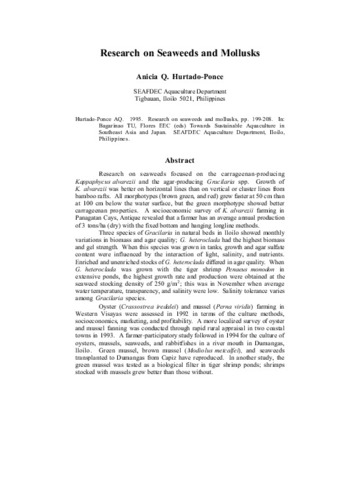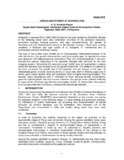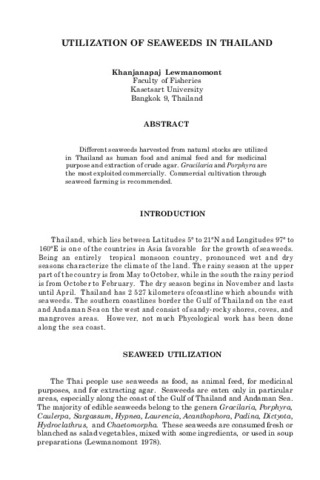Carpospore germination and early stages of development in Gracilaria edulis (Gmelin) Silva and Gracilaria rubra Chang et Xia (Gracilariales, Rhodophyta)
- Global styles
- MLA
- Vancouver
- Elsevier - Harvard
- APA
- Help

View/
Date
1993Author
Page views
2,214ASFA keyword
AGROVOC keyword
Metadata
Show full item record
Share
Abstract
Carpospore germination and early stages of development in Gracilaria edulis and Gracilaria rubra of the Philippines are described for the first time. Both species follow the "Dumontia type" or the immediate discal type of growth. Young plants with secondary branches were observed after 17 days of germination.
Suggested Citation
Hurtado-Ponce, A. Q. (1993). Carpospore germination and early stages of development in Gracilaria edulis (Gmelin) Silva and Gracilaria rubra Chang et Xia (Gracilariales, Rhodophyta). The Philippine Scientist , 30, 34-40. http://hdl.handle.net/10862/1421
Type
ArticleISSN
0079-1466Collections
- Journal Articles [1258]
Related items
Showing items related by title, author, creator and subject.
-
Research on seaweeds and mollusks
Hurtado-Ponce, Anicia Q. (Aquaculture Department, Southeast Asian Fisheries Development Center, 1995)Research on seaweeds focused on the carrageenan-producing Kappaphycus alvarezii and the agar-producing Gracilaria spp. Growth of K. alvarezii was better on horizontal lines than on vertical or cluster lines from bamboo ... -
Series: NACA Environment and Aquaculture Development Series No. 3
Gracilaria studies at SEAFDEC/AQD
Hurtado-Ponce, Anicia Q. (Network of Aquaculture Centres in Asia-Pacific, 1996)Research in seaweed from 1988–1994 focused on the agar producing Gracilaria. Studies in the following areas were also conducted: inventory of the seaweed resources; production ecology; farming systems; and agar characterisation. ... -
Utilization of seaweeds in Thailand
Lewmanomont, Khanjanapaj (Aquaculture Department, Southeast Asian Fisheries Development Center, 1990)Different seaweeds harvested from natural stocks are utilized in Thailand as human food and animal feed and for medicinal purpose and extraction of crude agar. Gracilaria and Porphyra are the most exploited commercially. ...




